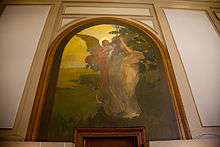Arthur Frank Mathews
| Arthur F. Mathews | |
|---|---|
 Oakland Public Library | |
| Born |
1860 Markesan, Wisconsin |
| Died |
1945 San Francisco |
| Nationality | American |
| Education | San Francisco School of Design, Académie Julian Paris |
| Known for | Painting |
| Movement | Arts and Crafts Movement, Art Nouveau, Tonalism |
| Awards | Grand Gold Medal, Académie Julian, 1886;Gold Medal for Distinguished Achievement in Painting, American Institute of Architects, 1923 |
Arthur F. Mathews (1860–1945) was an American Tonalist painter who was one of the founders of the American Arts and Crafts Movement. Trained as an architect and artist, he and his wife Lucia Kleinhans Mathews had a significant effect on the evolution of Californian art in the late 19th and early 20th centuries. His students include Granville Redmond, Xavier Martinez, Armin Hansen, Percy Gray, Gottardo Piazzoni, Ralph Stackpole, Mary Colter, Maynard Dixon, Rinaldo Cuneo and Francis McComas.[1][2][3][4][5]
Early years
Mathews was born in Markesan, Wisconsin, and lived there until he was six years old. His father, Julius Mathews, was an architect and moved the family to San Francisco in 1866. Like his brothers Walter and Edgar, Mathews learned architecture from his father; he then studied painting at the California School of Design, where he was influenced by Virgil Macey Williams. In San Francisco he also worked as a designer and illustrator at a lithography shop. He studied art in Paris at the Académie Julian from 1885 to 1889, where he was influenced by the academic classicism of his teachers Gustave Boulanger and Jules Lefebvre, the tonalism of James Abbott McNeill Whistler, and the symbolism of Pierre Puvis de Chavannes.
Life in San Francisco
Upon his return from Paris, Mathews taught life classes at the San Francisco Art Students League and the California School of Design. He became director of the latter in 1890, and in 1894, married Lucia Kleinhans, one of his art students.[1] He continued to teach there until the great 1906 San Francisco earthquake. Following the earthquake, he and Lucia opened the Furniture Shop in San Francisco. There he could unleash his combined skills as a craftsman, designer and painter. They also opened Philopolis Press and published the monthly Philopolis magazine, which promoted Arts and Crafts aesthetics in the rebuilding of the city. Among his many mural commissions was a twelve-panel series in the State Capitol Building, Sacramento.
Afternoon Among the Cypress in the permanent collection of the New York Metropolitan Museum of Art is typical of Mathews' landscape paintings of the Monterey Peninsula; Spring Dance at the Smithsonian American Art Museum is one of his many paintings of female figures in semi-classical attire. His work is extensively represented in the Oakland Museum of California.
Mathews was a master of many media: oil painting, watercolor, pastel, gouache and fresco. He and Lucia designed detailed interior decoration schemes in what became known as the California Decorative Style. They created a variety of furniture, boxes, carved and painted picture frames and many other decorative objects, and even large stained glass windows.
Significant permanent collections
Mathews' work is in the following major museums:
- Crocker Art Museum, Sacramento, California
- Fine Arts Museums of San Francisco, M. H. de Young Memorial Museum
- Hirshhorn Museum and Sculpture Garden
- Los Angeles County Museum of Art
- New York Metropolitan Museum of Art
- Oakland Museum of California
- San Diego Museum of Art
- Smithsonian American Art Museum
References
- 1 2 Berke, Arnold; Alexander Vertikoff (2002). Mary Colter, architect of the Southwest. Princeton Architectural Press. pp. 28–29. ISBN 1-56898-295-X. Retrieved April 17, 2010.
- ↑ Huntington, David C.; Detroit Institute of Arts (1983). The quest for unity: American art between world's fairs, 1876–1893. Detroit Institute of Arts. pp. 117–118. ISBN 0-89558-098-5.
- ↑ Jones, Harvey (1980). Mathews: masterpieces of the California decorative style. Oakland Museum.
- ↑ Jones, Harvey (2006). The art of Arthur and Lucia Mathews. Pomegranate. ISBN 0-7649-3549-6.
- ↑ Zellman, Michael David (1986). 1842–1874. American Art Analog. 2. Chelsea House Publishers in association with American Art Analog. p. 575. ISBN 1-55546-002-X.